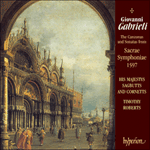
Welcome to Hyperion Records, an independent British classical label devoted to presenting high-quality recordings of music of all styles and from all periods from the twelfth century to the twenty-first.
Hyperion offers both CDs, and downloads in a number of formats. The site is also available in several languages.
Please use the dropdown buttons to set your preferred options, or use the checkbox to accept the defaults.

| His Majestys Sagbutts & Cornetts» More |
The canzona starts seriously, but leads through a madrigalian succession of contrasted, though related, melodies, each section rounded off by a clear cadence. The texture varies kaleidoscopically, the mid-point marked by a strikingly simple phrase in four-part harmony. A straightforward tripla, heard twice, leads into the closing canonic ‘Amen’.
from notes by Timothy Roberts © 1997
 Gabrieli (G): Sacrae Symphoniae Gabrieli (G): Sacrae Symphoniae‘This superb disc … is the very essence of La Serenissima. Masterly performances, alive with authentic detail’ (BBC Music Magazine) ‘Excellent. The playing is fluent and exhilarating. An excellent recording. The notes are exemplary’ (Classic CD)» More |

